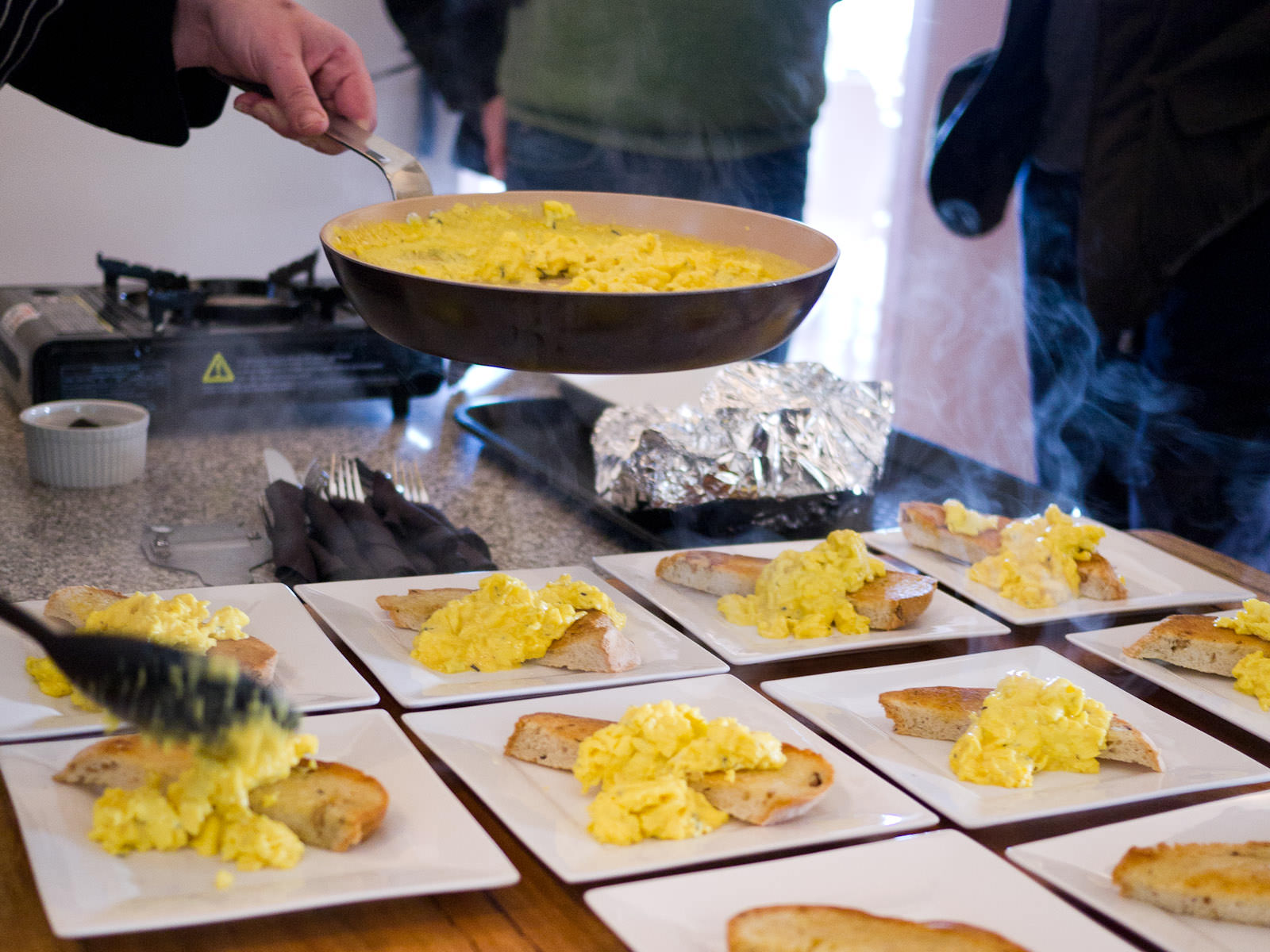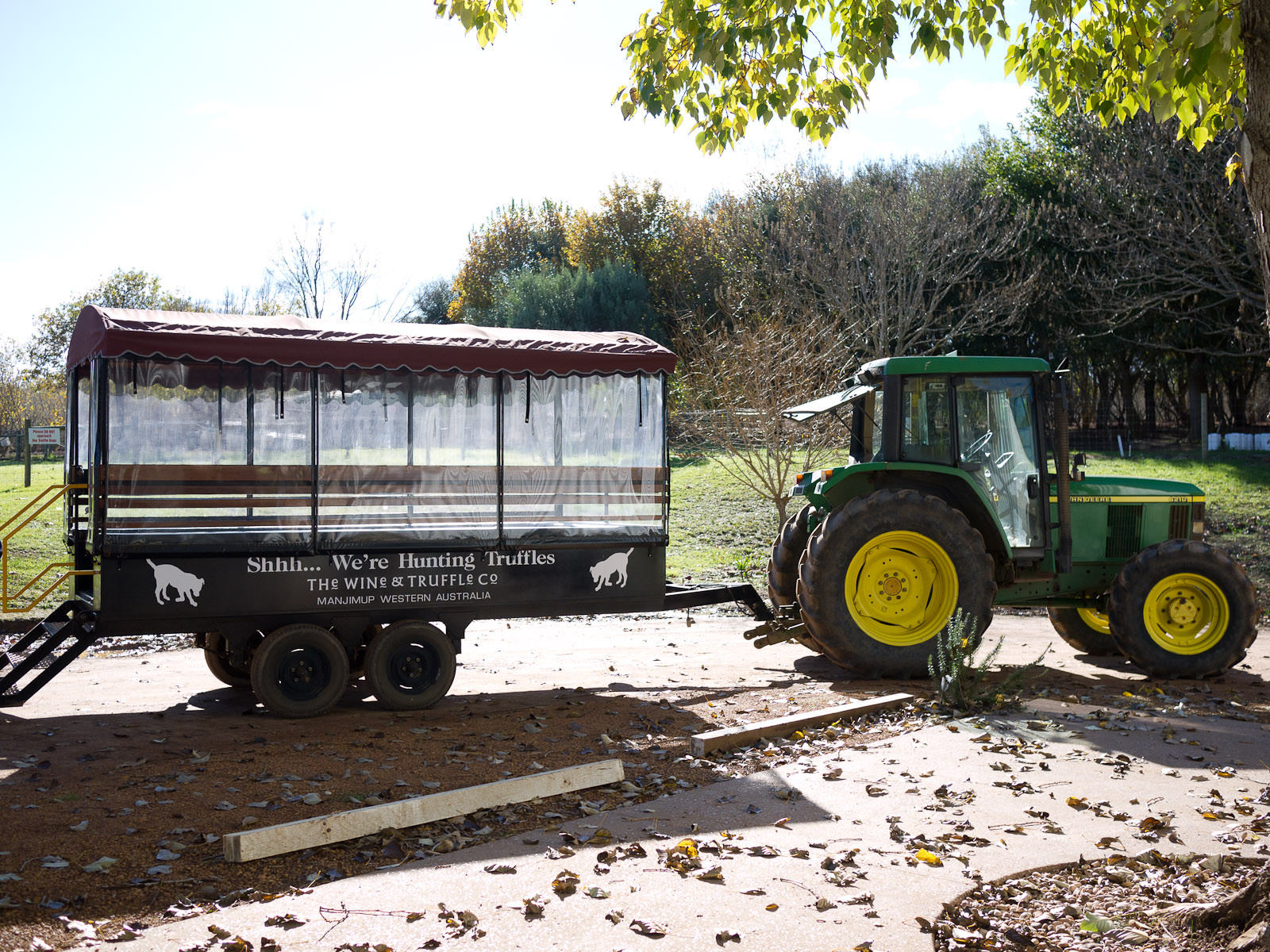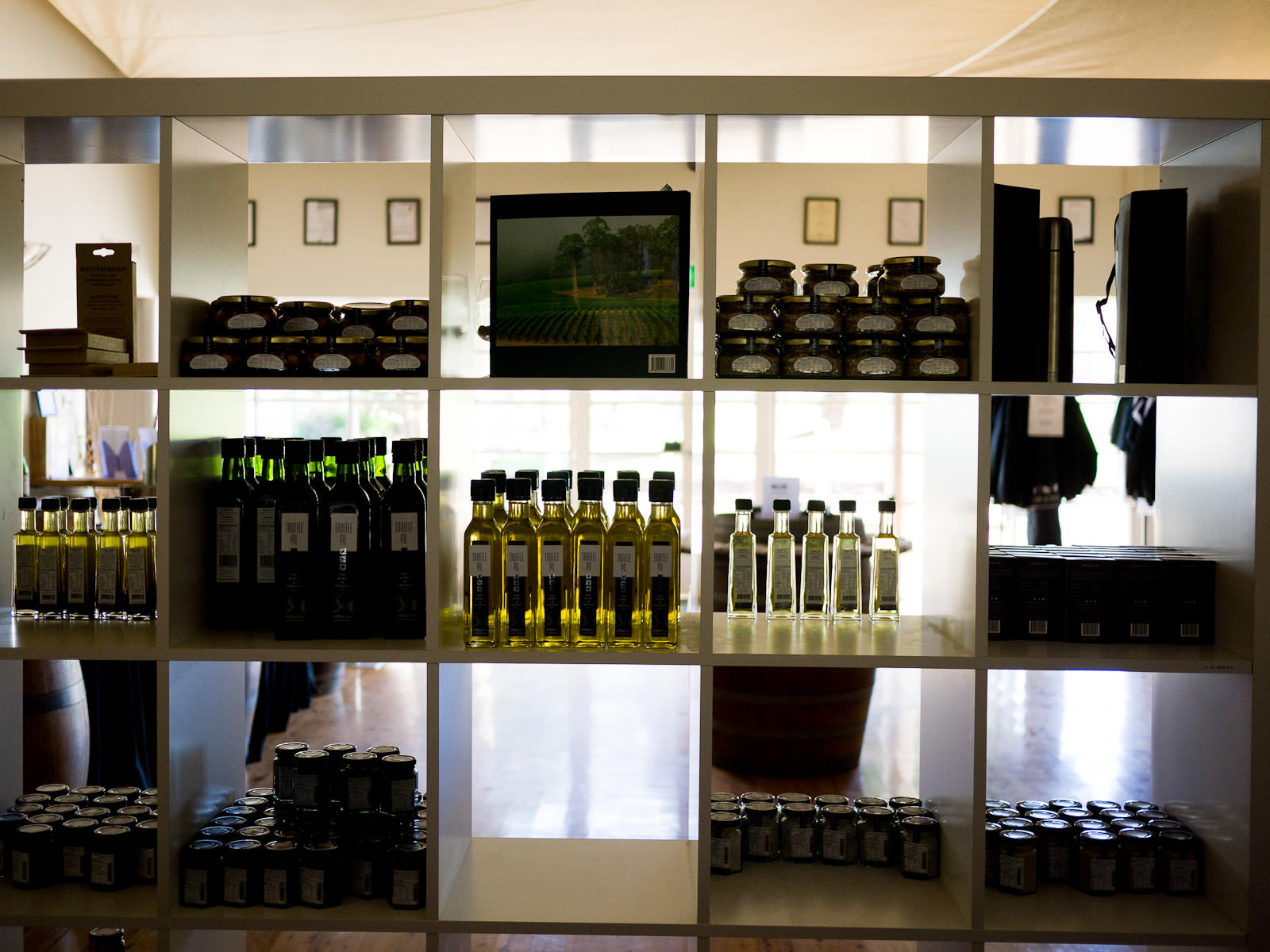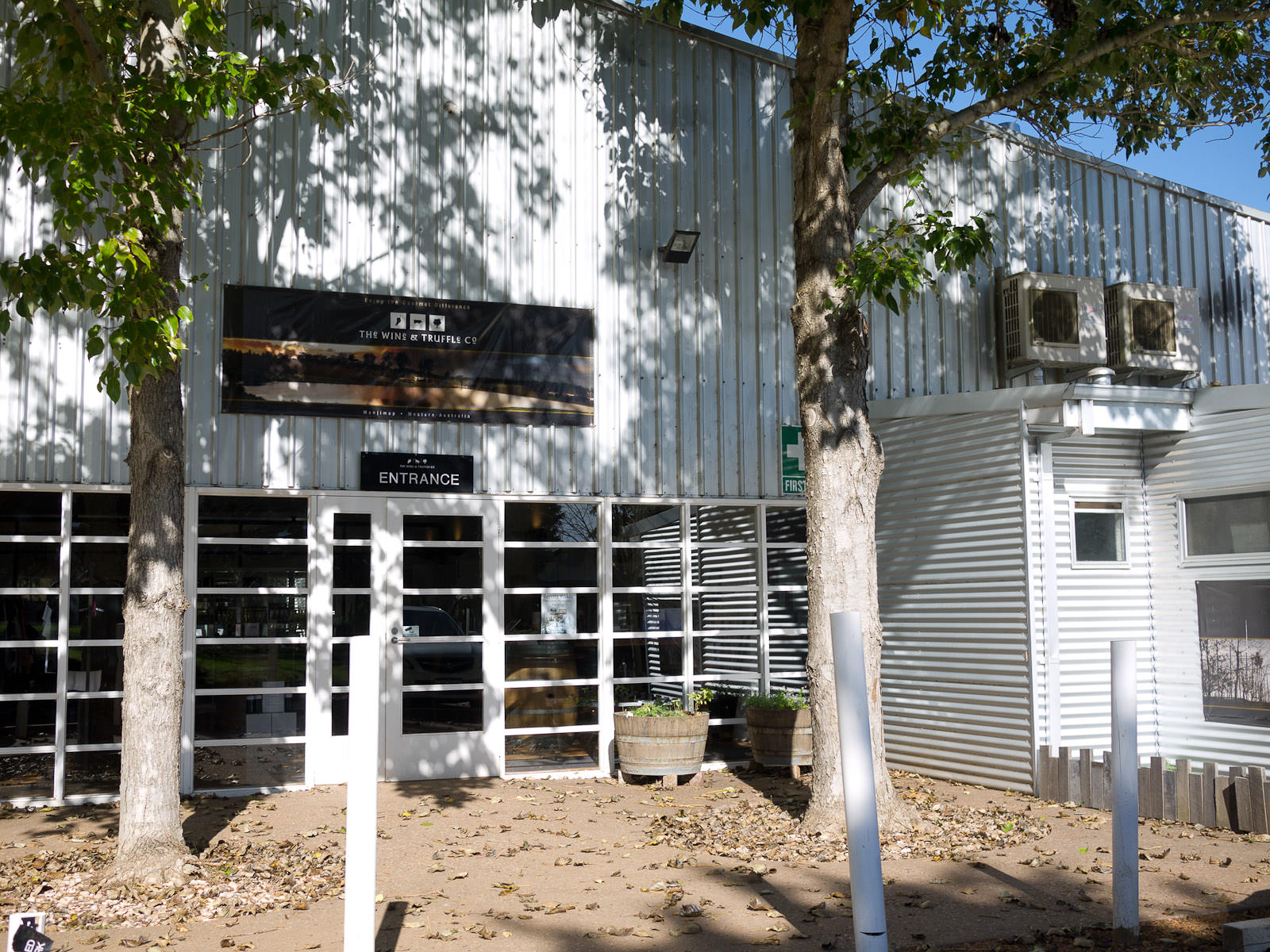Truffle hunt, The Wine & Truffle Co, Manjimup
Going on a truffle hunt is an exhilarating culinary adventure. And you can experience it right here in Western Australia.
Truffles are a rare, much sought-after delicacy, an edible fungus that fetches AU$2000 to $3000 a kilogram. They have a pungent, distinctive aroma and flavour that, once experienced, is never forgotten.
Truffles grow underground on the roots of suitable trees that have been innoculated with truffle spores. They can be found from as little as 5cm to as deep as 30cm below the ground, within a meter of the base of the host tree. You need patience, passion and dedication (not to mention money) if you have great truffle expectations, for truffles will take at least 5 years, if not more, to develop. To find them, you need an animal with a sensitive nose trained to identify where the ripe truffles are growing underground, before you harvest them by hand. This adds to the romance, challenge and premium price of cultivating truffles.
Here in Western Australia, the season lasts for the three winter months, June to August. During this time, truffle enthusiasts and food adventurers can experience the excitement of a truffle hunt at The Wine & Truffle Co in Manjimup. Going on a truffle hunt has been high on my food To Do list so you can imagine my joy at being here, looking a scene so picturesque it feels almost surreal.
Western Australia’s first truffière (truffle orchard) was established here in Manjimup in 1997 with the planting of hazel and oak trees inoculated with Périgord truffle spores imported from France. It took six more years before the first truffle was found. It weighed 168 grams and was around the size of a cricket ball. Since then, the annual harvest has steadily increased each year. Western Australia is now the biggest producer of black Périgord truffles outside of Europe, with the majority being produced in Manjimup. The Wine & Truffle Co is the largest producer of truffles in the southern hemisphere. This year’s harvest is expected to exceed 2.5 tonnes.
The Wine & Truffle Co cafe chef Lea cooks up a batch of truffled scrambled eggs for us. The eggs are buttery soft, gloriously yellow and dotted with specks of black truffle, served straight from the hot pan over toasted bread made with hazelnuts from the trees that grow in the truffière.
Cooking tip: if you store truffle with eggs in an airtight container for a couple of days, the intense aroma will penetrate the shells, creating truffle-infused eggs.
Just before serving, these decadent scrambled eggs on toast are topped generous shavings of fresh black truffle. Is it good? Oh yes.
For those who have not experienced truffle, words can never quite describe its intense, unique and intoxicating aroma and flavour – a little goes a long way; too much can be overpowering. People have described it as rich, savoury, musky, earthy, garlicky, nutty – once you’ve experienced it, you will always recognise it.
There are white truffles, also known as “Alba Madonna”, which devotees will fiercely declare are superior to the black truffle. I would love to taste white truffle someday and decide for myself. To date, no one has successfully grown white truffles outside of Europe.
Are you a truffle fan?
We get into protective coveralls, pull on gumboots and head over to the tractor-pulled cart that will carry us through the property right into the heart of the truffière. Just a fortnight ago, a big storm resulted in fallen trees, property damage and power blackouts throughout in the region. Today, we’ve been blessed with sunshine.
The truffière is stunningly beautiful. The air is fresh and bracing. It’s cold in the shade but dozy warm in the sun. We tread carefully through the crinkled leaves and the crunch of fallen hazelnuts, now acutely conscious that we may be walking on buried treasure.
We are met by our truffle hunting team for today, dog handler Shane and her gorgeous labrador Zeta. We’re not supposed to pat the truffle dogs while they are working, but before getting down to business, Zeta greets everyone vivaciously, barking with excitement, tail wagging merrily. The Wine & Truffle Co has a team of specially trained dogs that covers 42 km each week, sniffing out the ripe truffles all along the neat rows of hazel and oak trees. Good truffle hunting dogs are able to locate truffles growing as deep as 30cm beneath the earth. The yellow ribbons hanging on the pouch on a truffle hunter’s belt are used to mark the spots identified by the dogs so that harvesters can quickly retrieve the truffles.
Using specific commands, Shane gets Zeta to work, keeping her focused and encouraged as she snuffles through the crackling leaves.
When Zeta finds a truffle, she marks the ground, tapping with her paws. Most of the truffles Zeta finds today are growing quite close to the surface. Shane verifies that each one is ripe and ready to be harvested, then invites one of us to carefully dig it up.
For her efforts, Zeta is praised and rewarded with liver treats kept in a pouch on Shane’s belt. In France, female pigs have been traditionally used to forage for truffles – it is believed they are naturally attracted to truffles because to them, the odour of ripe truffles resembles the sex pheromones given off by a boar. The problem with this is that sows find truffles to be an irresistibly tasty treat and eat them as quickly as they locate them. It was not uncommon for truffle hunts to develop into battles that resulted in lost fingers. Dogs aren’t natural truffle hunters but once trained, are an effective, less problematic substitute.
Freshly retrieved, the truffles have a smell of rich earth and damp forest. The ideal truffle size ranges from golf ball size to tennis ball size, though they can come smaller and bigger than that. If you didn’t know what they were, you’d never imagine how highly prized these dirty, knobbly black lumps are. Mature truffles must be harvested within about three days of ripening; if they aren’t dug up, they will break down into the soil. Overripe truffles produce spores that can be used for inoculating trees, so there is benefit to retrieving them even though they aren’t good for eating.

Truffles fresh out of the ground. They leave their fragrance in the hands of everyone who handles them
Our truffle hunt is short and sweet, but we’ve all had a thrilling time, following eagerly behind Zeta, each of us having a turn gently unearthing and retrieving the truffles she finds. In just fifteen minutes, we’re amazed – we’ve harvested around 1 kg of truffles. No, we don’t get to keep any. These beauties will now be cleaned, washed and graded.
Back at The Wine & Truffle Co shop, we taste truffle mustard, truffle oil, hazelnut dukkah, mushroom tapenade and my favourite, hazelnuts in truffle honey. Jac and I have made lunch plans in Pemberton, but I stick my nose briefly into the cafe and the smell is enticingly truffley.

Truffle tasting – truffle mustard, truffle oil, hazelnut dukkah, tapenade and my favourite – hazelnuts in truffle honey
In addition to establishing the truffière back in 1997, The Wine & Truffle Co planted 30 acres of wine grapes. The fruit from these vines is combined with grapes sourced from vineyards in Manjimup and Pemberton to create Truffle Hill wines, which are produced at the winery in Mt Shadforth, Denmark. The label pays tribute to the truffle dog.
As I prefer sweet fruity wines, I ask to taste the sweetest wines in the Truffle Hill range. They are “The Doctor” Half Dry Riesling, named in honour of Dr Nick Malajczuk, one of the founding members of The Wine & Truffle Co, and the Truffle Hill Reserve Series Cane Cut Riesling 2011, a sweet dessert-style wine. Both are easy drinking and we enjoy them so much we buy a bottle of each to take home, along with a jar of truffle mustard and a jar of truffle honey. As we pay for purchases, I’m already thinking about fresh crusty bread spread generously with butter right up to the edge, drizzled with lashings of that golden truffle honey.

The Wine & Truffle Co shop interior – I love the use of barrels – they give the airy, elegant shop a rustic feel
It’s been a brilliant eye-opening and delicious morning. We leave with a deeper appreciation for the people who first dared to dream of growing Périgord black truffles in this unassuming Western Australian country town, and the endless hard work and dedication that have made it possible for truffles to become one of our finest local foods. And let’s not forget the faithful furry friends who help sniff out the precious black gold.
The Wine & Truffle Co
Manjimup Office, Truffière, Cafe and Cellar Door
Lot 490 Seven Day Road, Manjimup
Telephone: (08) 9777 2474
- Truffle hunts are held during the fresh truffle season from 1 June to 31 August on Saturdays and Sundays only.
- Each session starts at 9.30am and ends at approximately 12 noon.
- Cost is AU$95 per person.
- Protective coveralls and boots are supplied for the hunt.
- Not suitable for people with nut allergies as you will be walking around hazelnut trees.
The cafe is open for lunch Thursday to Sunday and public holiday Mondays 10am to 3.30pm, with an a la carte menu that showcases the truffle.
The cellar door is open daily including public holidays 10am to 4.30pm.
About Manjimup
Manjimup is a country town in Western Australia’s Southern Forest region, 307km from Perth, approximately 3.5 hours drive. All around are the towering majestic karri trees and the air is clear and crisp. The town’s major industry is timber but the “Manjimup black truffle” is fast becoming its most famous export. The pink lady apple was developed in Manjimup and the Cherry Harmony Festival is held in Manjimup every December.
EDIT, 2013:
Truffle Kerfuffle 2013 is on 22 June in Manjimup.
The Mundaring Truffle Festival has been cancelled for 2013.
Truffle Kerfuffle
We weren’t able to make it this year to Truffle Kerfuffle, the Southern Forest Food Festival, which was held on 16 June at Fonty’s Pool in Manjimup. The festival featured popup kitchens and cooking masterclasses, WA wine tastings, truffle hunts and special dining events to celebrate the truffle. Over 2500 people attended this year’s event. Truffle Kerfuffle will be back for its third year on 22 June 2013.
Mundaring Truffle Festival 2012
It’s around 45 minutes drive Perth to Mundaring. This year’s festival is on 28 and 29 July. Tickets for general entry are available online for AU$16 or $19.50 at the gate. There will be cooking demonstrations, truffle dog demonstrations, the food piazza featuring lots of truffle dishes, and a gourmet produce market where you can meet local producers, enjoy free tastings and purchase truffles by the gram. A number of events are ticketed at extra cost; the truffle masterclass has sold out already, but places at the 5-course long table lunch are still available for both days, though you’ll need to be quick.
For more information, visit the Mundaring Truffle Festival website.
See my post about the Mundaring Truffle Festival 2011 – show highlights for me last year were the truffle dog demonstrations, Must Winebar’s chicken and truffle ice cream, and pork belly with truffle, crackle dust and apple sauce at the Linley Valley Pork stand.
Coming up at The Food Pornographer
More Manjimup
I found out about The Wine & Truffle Co’s truffle hunts not long after last year’s season ended, and had been waiting impatiently to book us in for a truffle hunt this winter. We decided to stay in Manjimup for the weekend – stay tuned for more posts on our Manjimup getaway. This was not a sponsored trip.
Truffle degustation
In the spirit of truffle season, last night, Jac and I attended a truffle degustation dinner at Lamont’s Bishop’s House in Perth. Celebrity chef and restaurateur Kate Lamont introduced the food and the wine matches and even dropped by our table for a chat, sharing her food philosophy and thoughts on the truffle. That post to come next week.
TFP’s e-newsletter
I published the first edition of my e-newsletter this weekend. If you’ve subscribed, I hope you enjoyed it!
For those who haven’t subscribed, check out the newsletter here: TFP e-newsletter #1.
If you like it, I hope you’ll consider subscribing so you don’t miss out on future editions.

















